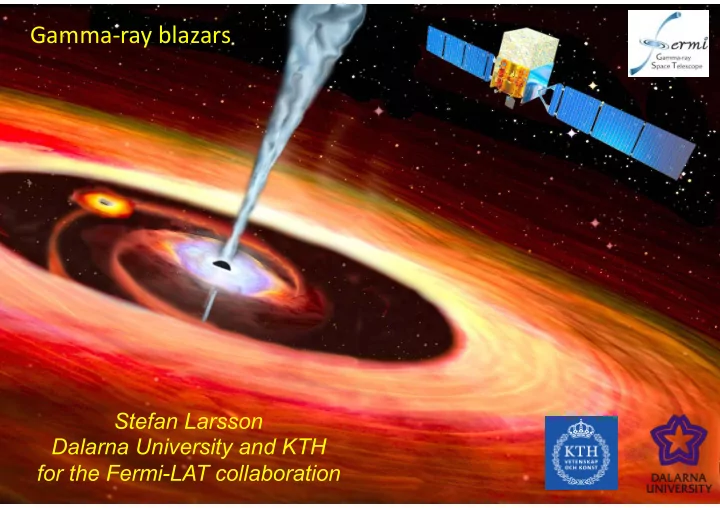

Gamma-ray blazars Stefan Larsson Dalarna University and KTH for the Fermi-LAT collaboration
Blazars Blazars are AGN with a relativistic jet pointing towards our line of sight Doppler boosting: Bright and rapidly variable Boston University Blazar Research Group Lund 2020 Stefan Larsson http://www.bu.edu/blazars/bllac_files/agn_nature_cam3_360sqpix.mov
Fermi-LAT Sky map (9 years) > 5000 point sources Energy range 100 MeV - 300 GeV Lund 2020 Stefan Larsson
Blazar variability Variability and MW Correla*ons: A few examples Periodicities? ✦ Gravitational lensing ✦ 3C279: ~5 minute time scale variability ✦ rms - flux relation? ✦ Radio - gamma-ray correlation ✦ Lund 2020 Stefan Larsson
Fermi-LAT light curves monthly (2FGL) Lott et al (2012) adaptive ( σ =25%) Lund 2020 Stefan Larsson
Blazar periodicities? PG1553+113: A quasi-periodic flux modulation? (Ackermann et al 2015 ApJL 813 L41) P ~2 years? Lund 2020 Stefan Larsson
Blazar periodicities? PG1553+113: A quasi-periodic flux modulation: Yes Cutini et al (in preparation) 3.0 × 10 -8 Preliminary 2.5 × 10 -8 Flux (E > 1 GeV) [ cm -2 s -1 ] 2.0 × 10 -8 BH binary? 1.5 × 10 -8 Accr. disc QPO? 1.0 × 10 -8 5.0 × 10 -9 54000 55000 56000 57000 58000 59000 MJD Lund 2020 Stefan Larsson
B0218+357: A gravitationally lensed blazar Lag = 10.5 ± 0.4 d data ( Biggs et al 1999) Lund 2020 Stefan Larsson
B0218+357: A gravitationally lensed blazar Lag = 11.46 ± 0.16 d (Cheung et al 2014 ApJL 782 L14) Lag = 10.5 ± 0.4 d Fermi ToO pointing (Biggs et al 1999) Flaring Interval 2012 Jun 22 − 2013 Mar 14 1st 2nd 5 1 − day bins 3rd − 1 ) 4 − 2 s − 6 photons cm pre 3 post 2 γ (10 F 1 0 0 50 100 150 200 250 T (MJD − 56100 days) Autocorrelation analysis of Fermi- LAT data Biggs & Browne (2018) reanalysis => Lag = 11.3 ± 0.2 d => H 0 = 72.9 ± 2.6 km s − 1 Mpc − 1 Lund 2020 Stefan Larsson
3C 279: Rapid variability In bright states a few sources have shown variability on time scales of 10 minutes or less.(Ackermann et al 2016)) Lund 2020 Stefan Larsson
- D 3C 279 Power Density Spectrum Also the Power Density Spectrum differ between the two epochs (Ackermann et al 2016) 3C 279 First 3.5 year epoch Second 3.5 year epoch 2015 outburst (~2 weeks) Overlapping PDS is consistent with constant RMS/Flux Lund 2020 Stefan Larsson - - a b µ
The RMS-Flux relation at gamma-ray energies 3C 279 RMS-Flux (> 100 MeV) for the first (+) and second (diamonds) 3.5 years of Fermi-LAT observations (flux binned) y r ( ph cm -2 s -1 ) a n i m i l e r P ( ph cm -2 s -1 ) Non/slowly variable component? Lund 2020 Stefan Larsson
RMS - Flux relation in X-rays A linear relation is well Uttley & McHardy,2001,MNRAS,323,L26 established for X-ray binaries. Consistent with accretion disc models Suggested also in X-rays for 3C 273 and 3C 279. But origin of the X-ray emission is unclear. McHardy (2008) Fig.2. Left Panel rms-flux relationship for Cyg X-1 [22] 2.5 0.8 3C 273 3C 279 2 0.6 1.5 RMS RMS 0.4 1 0.2 0.5 0 0 1 1.5 2 2.5 3 6 8 10 12 14 Lund 2020 Stefan Larsson FLUX FLUX Fig.5. Left Panel rms-flux relationship for 3C273 derived from the X-ray lightcurve shown in Fig.4.
The RMS - Flux relation and jet models In addition to power spectra, the RMS-Flux relation should also be used as a test of models Marscher (2014) Lund 2020 Stefan Larsson
Radio - Gamma-ray correlation Fuhrmann et al (2014) The method in brief: J1159+2914 1.5 1.5 relative timing of flares DCCF 1.0 1.0 J1159+2914 8e-07 Fermi-LAT statistical Discrete -1 ] -2 s 0.5 0.5 flux (E>100 MeV) [ph cm Cross-Correlation 6e-07 Function analysis 4e-07 0.0 0.0 2e-07 DCCF 0 0.8 mm -0.5 -0.5 2 mm 3 mm 4 7 mm 9 mm 13 mm flux density [Jy] 20 mm 3 -1.0 -1.0 28 mm 36 mm 60 mm -600 -400 -200 0 200 400 600 -600 110 mm 2 LAG (Days) 1 54800 55000 55200 55400 55600 55800 MJD Lund 2020 Stefan Larsson
Radio - Gamma-ray correlation Fuhrmann et al (2014) The method in brief: J1159+2914 1.5 1.5 relative timing of flares DCCF 1.0 1.0 J1159+2914 8e-07 Fermi-LAT statistical Discrete -1 ] -2 s 0.5 0.5 flux (E>100 MeV) [ph cm Cross-Correlation 6e-07 Function analysis 4e-07 0.0 0.0 2e-07 DCCF 0 0.8 mm -0.5 -0.5 2 mm 3 mm 4 7 mm 9 mm 13 mm flux density [Jy] 20 mm 3 -1.0 -1.0 28 mm 36 mm 60 mm -600 -400 -200 0 200 400 600 -600 110 mm 2 LAG (Days) 1 54800 55000 55200 55400 55600 55800 MJD Stacked DCCF 0.4 0.3 Highly significant average 0.2 DCCF correlation for 0.1 Stacking (54 sources) the sample 0.0 -0.1 -0.2 -600 -400 -200 0 200 400 600 Lund 2020 Stefan Larsson
Radio - Gamma-ray correlation Fuhrmann et al (2014) Radio time lag as a function of radio frequency 2.0 11 cm DCCF 1.5 − 1 100 τ = Α + Βν 2.1 80 1.0 1.8 time lag [days] log (time lag) 1.5 60 1.2 0.9 0.5 0.6 40 0.3 0.5 1 1.5 2 2.5 log (frequency) 0.8 mm 20 0.0 0 0 50 100 150 200 250 300 350 frequency [GHz] -0.5 -400 -200 0 200 400 LAG (Days) Lund 2020 Stefan Larsson
Summary In summary: The regular sampling and essentially continuous coverage of Fermi-LAT light curves over more than a decade allow us to conduct detailed statistical studies of variability and multi wavelength relations for blazars. Analysis of blazar light curves provides information on the structure and dynamics of AGN jets. Lund 2020 Stefan Larsson
Recommend
More recommend